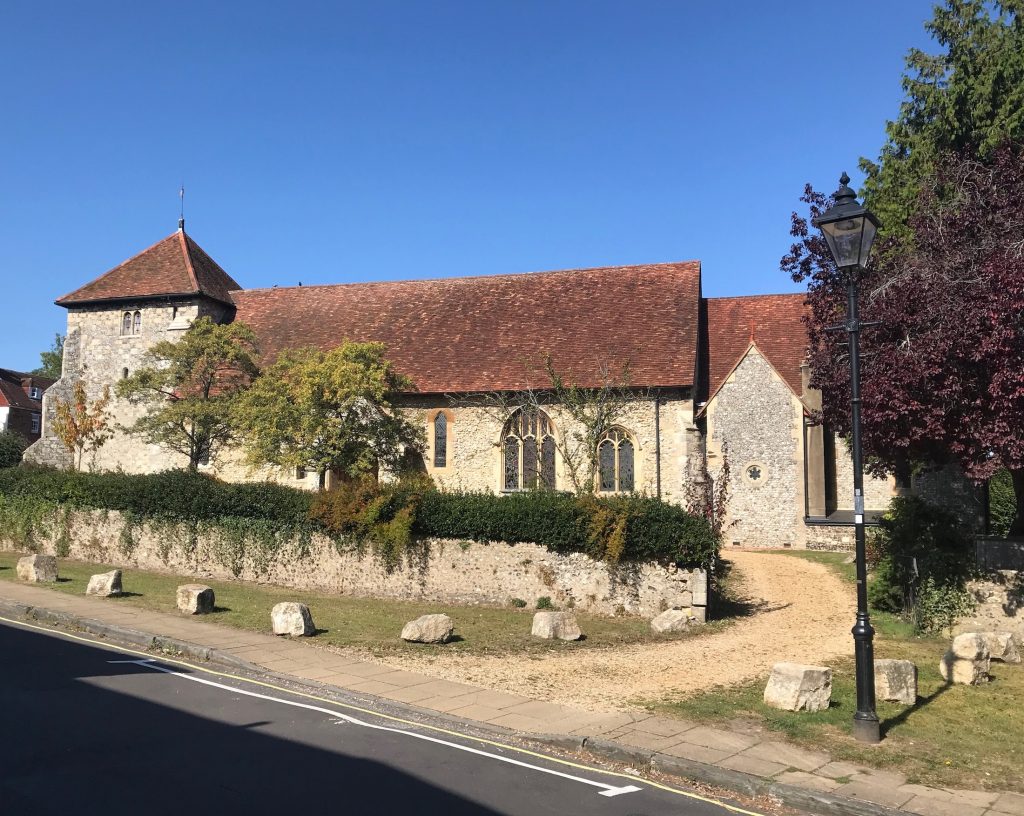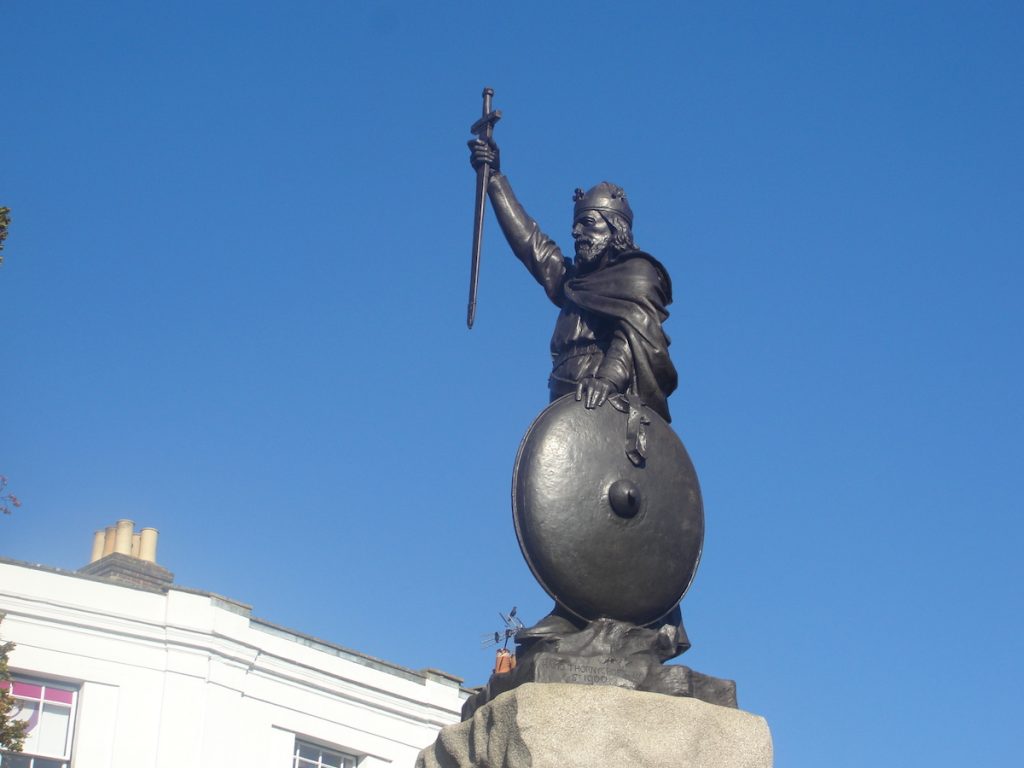This post on Hyde Abbey is adapted and condensed from my book, King Alfred: A Man on the Move, available through Amazon and bookshops. This is my second post on Winchester, the first is located here.
King Alfred was buried at Winchester, in Hampshire, but the location of his remains are unknown. His remains were moved at least twice and the different religious buildings built at different times can cause confusion in trying to work out where these remains went. I refer you to my first post on Winchester for the first two locations of Alfred’s remains, the Old Minster and the New Minster.
In 1109 Henry I ordered that the New Minster be moved to land that he had provided at Hyde, which was then just outside Winchester. It is possible that the New Minster had suffered from a fire prior to 1109, which might have made the move opportune, or perhaps Henry I did not want the Saxon New Minster cramping the style of the gleaming Norman Winchester Cathedral. The re-located New Minster would then become known as Hyde Abbey. In my opinion, the location of this abbey must be one of the most important of the lesser-known sites in British history, and it deserves to be much more famous.

Documents indicate that Alfred was transferred to Hyde Abbey in 1110 and that he was interred in front of the altar. Today, Hyde is just north of the city centre and can be easily visited by walking north up Hyde Street, and then turning right into King Alfred Place. This leads to the location of the altar of Hyde Abbey where three stone slabs show where Alfred, his wife and his son were once buried.

Hyde Abbey was destroyed in 1539 in Henry VIII’s dissolution of the monasteries. Furthermore, the Annals of Winchester tell us that Hyde Abbey was burnt in 1141, which fits with another record that tells us that the abbey laid “in ruins” after having been set alight in a battle between King Stephen and Matilda in 1141. It seems possible to me that Alfred’s and other important remains could have been relocated in 1141, or prior to the 1539 dissolution. However, the discovery of part of a pelvis (see below) shows that bones from the Anglo-Saxon period remained.
There is a detailed story (for those interested, this is in my book) about how eventually some bones, thought to include those of King Alfred, ended up being interred in the grounds of St Bartholomew’s church, which is located within the footprint of the precinct of Hyde Abbey. However, when these bones were radio-carbon dated, they were found to be more recent than the Anglo-Saxon period. This was the subject of a TV documentary, which you may have seen. To cut a long story short a prison was built on the site in the 1780s and about a decade or so later a Henry Howard made enquiries and was informed by Page (the overseer of the prison construction) about what was found, from which Mellor made a “rough drawing”. The following quote from Howard’s text, which appeared in Archaeologia in 1800, along with his sketch, is most interesting:
“About a [on Howard’s drawing] was also found a stone coffin cased with lead both within and without, and containing some bones and remains of garments. The lead in its decayed state sold for two guineas; the bones were thrown about, and the stone coffin broken into pieces. There were two other coffins, and no more, found in this part, which were also for the sake of the garden, in which they lay, broken and buried as low as the spring.”
I apologise for not putting up an image of his sketch because of copyright etc.
Point a on his drawing seems a plausible location for near the high altar. However, he goes on to say that many more stone coffins were found both to the east (outside the east wall) and the west of this location (in the nave). Clearly, in a situation where bones had been “thrown about”, bones near the altar may not have started off there. The point about the well was taken up by a Mellor who indeed found bones there and sold them to the vicar of St Bartholomew’s, and it seems that these are the bones that ended up collectively buried to the east of that church.

Nonetheless, testing was carried out on bones from an excavation at the main site of the abbey undertaken in the 1990s, and a sample from an approximately middle-aged (to us!) male pelvis was dated to 895-1017. Although dating to the correct period, because King Alfred died in 899, it is not possible to say whether this pelvis once belonged to him. King Edward the Elder, who died in 924, was also buried at Hyde Abbey and there is evidence that other individuals may have been too: Æthelweard (a son of Alfred), or Ælfweard (son of King Edward the Elder, although he may have been too young to match the profile of the bone), a monk called Grimbald (although he died quite old) and St Judoc (who, however, died in the 7th century). There may, of course, have been other individuals for which we have no record. Because the bones were found in the vicinity of the high altar (even if it was in back-fill from a Victorian dig) it seems to me not impossible that the bone is from King Alfred, King Edward the Elder, or Æthelweard. Slightly worrying, though, is a record from 1798 that tells us that when a prison was built on the site, bones that were found were “thrown about.” This might mean that what is found near the high altar might not have started off there. Furthermore, would the builders then build over these scattered bones or have them removed? The latter seems more likely. We must remember that Richard III was discovered under a car park in Leicester, so we should perhaps always be ready to be surprised. Richard III, however, died almost 600 years more recently than King Alfred, something that I assume made using a live relative for a DNA comparison (as was done with Richard III) more straight forward. There may have also been less change in use of the land over time in the case or Richard III.
It was hoped that DNA from the pelvis fragment could be matched with those of King Alfred’s grand-daughter, Eadgyth, who was buried at Magdeburg, in Germany. However, although it was thought that it would be possible to extract DNA from the pelvis fragment, it seemed that the remains of Eadgyth were too poorly preserved to attempt a match.
This is a special place to visit, and I always make time to come here whenever I am in Winchester. In fact, this location was one of my main inspirations for writing my book. It is a hugely important location in the history of England.

There is a community group called Hyde 900 that has done a lot of work in relation to the former abbey, and they deserve a mention. Their website also has more information.












